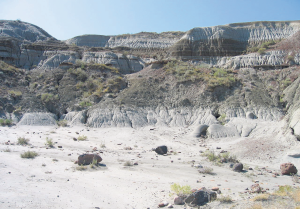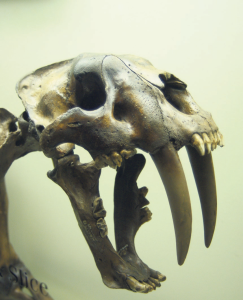FRIDAY, 25 JANUARY 2013
In may of this year, a dinosaur fossil hit international headlines. The specimen, a beautifully preserved Mongolian tyrannosaur called Tarbosaurus bataar, had sold at auction in Manhattan, New York for US$1.05 million. Amid an outcry from palaeontologists, Mongolian president Elbegdhorj Tsakhia intervened, alleging that the Tarbosaurus had been collected illegally, part of a booming trade in stolen and smuggled fossils. The case, still ongoing, is a window into a thriving industry which is littlenoticed by most people, but a constant menace to our understanding of past life.The problem of irresponsible fossil collectors is nothing new. Some Victorian collectors, taking their cue from big game hunters, would routinely hack the skull off an impressive fossil, leaving the rest, now headless, in the rock. The glamour of big species, particularly carnivorous ones, is still a powerful driver in today’s fossil markets. A single tooth from a Tyrannosaurus rex found in Montana in 2011 sold for £36,000, and another T. rex, nicknamed ‘Sue’, became the world’s most expensive dinosaur fossil when it sold to the Field Museum in Chicago for US$8.4 million. But increasingly, private collectors want more scientifically important fossils, which often requires illegal collecting. Famous invertebrate localities such as the Ediacara Hills in Australia, or the Burgess Shale in Canada are regularly targeted too. Losing dinosaurs to private collectors is unfortunate, but the little-publicised loss of these more obscure fossils is an equal scientific tragedy.
The rocks of the White Sea-Arkhangelsk region of Russia hold some of the earliest traces of animal life on Earth, preserving an aquatic ecosystem over 550 million years old. Increasing scientific interest has come at a predictable price – there has also been an increase in poaching, evidenced by tools, rubbish and disordered dig sites left behind. Since 2005, huge illegal excavations have been made in the area, removing hundreds of cubic metres of fossil-bearing rock. Worse, the nature of the fossil deposits means that widely varying communities of mysterious Ediacaran organisms are localised in very small areas, each with their own unique fossil fauna. A single poaching expedition, targeting one of these tiny communities, could remove dozens of species from the fossil record forever. If we’re lucky, they may be rediscovered once they go to sale – new species from the area have shown up at international fossil fairs - but they are likely to be just a taster of the ancient biodiversity lost on the illegal market every year.
Governments have forged a variety of laws to protect their most important fossils. Heavy fines or imprisonment are usual penalties, but whatever the law says, all governments hit the same major problem: enforcement is almost impossible. Protecting fossil rich areas often requires sending patrols over a huge, remote area. In the USA, the National Parks Service employs a network of monitoring staff to repeatedly survey important fossil sites for signs of poaching. If signs are found, palaeontologists may carry out an ‘emergency excavation’, involving rapid removal of all the fossils in the area. Emergency excavation safeguards some fossils, but it doesn’t catch poachers, and can only work after poaching has begun, so some of the fossils have already been lost. Could scientists do more to combat the problem?
The problem of conserving Earth’s palaeodiversity has obvious but under-recognised parallels with our efforts to conserve modern ecosystems. As with modern conservation efforts, better communication with communities living near important sites could work wonders to help. Canadian fossil hunter Michael Ryan, describing work in the Gobi desert, articulates the problem well: ‘They see us driving these big fancy trucks and taking the bones away. As rich Europeans and North Americans coming in there, it’s hard to say, “Thou shalt not do these things,” because that’s what it appears we’re doing.’ Besides, not all fossil poachers are out to make big profits. Whether palaeontologists like it or not, fossils represent a stunning economic resource for poorer people who happen to live in fossil-rich areas. When even small fragments of bones or teeth can fetch hundreds of dollars, the fossil record begins to look like a natural resource just like any other. Casual collecting on protected land can also damage the record, though collectors do not always realise it. In cases like this, a little more dialogue between palaeontologists and local communities could be all that’s needed to reduce losses.
When important fossils are discovered, the findings too often go into the scientific literature and are not shared with a wider audience. Well-publicised fossil localities can be an important draw into an area, and in some cases even generate a tourist industry of their own. North America is world-leading at this, drawing hundreds of thousands of palaeo-tourists every year to exceptional fossil localities such as the La Brea Tar Pits and Mammoth Hot Springs in the USA, and Dinosaur Provincial Park, in Canada. Yoho National Park, the home of the Burgess Shale, also cashes in on its palaeontological heritage, running popular guided hikes up to the important outcrops. This approach clearly won’t work everywhere, but with enough resources, good fossils can be exploited without harming scientific endeavour. There will always be a need for patrolling and straightforward law enforcement, but with a little imagination, people can benefit from their fossil resources without destroying them.
In the summer of 2010, I was looking for fossils in the Badlands National Park, South Dakota. For weeks, I and the field team I was working with had been finding wonderful fossils in the crumbling mudstone of the Badlands - sabre-toothed cats, rhinos, early dogs, horses, camels, turtles and alligators. Alongside the US National Parks Service, we had been prospecting in remote areas which had been closed to palaeontologists for decades. The rocks were prolific and the fossils often fascinating, too numerous to collect. As I worked, I began to construct a mental picture of these creatures, visualising how they might have moved, and the landscapes where they might have lived. The South Dakota of 35 million years ago began, very gradually, to take shape.
A week or so later, things had changed. We had moved to a new locality in the same rocks, this one an easy stroll from the highway, a long blue ribbon through the barren landscape. In a day of searching under the huge, white sun, we found nothing. Not a splinter of bone, nor a solitary tooth, remained. This ancient and bizarre fauna had been entirely erased. In researching this article, I found fossils from those Badlands rocks on sale online for hundreds or thousands of dollars. We might not realise it immediately, but those figures have terrible implications for fossil conservation, as the market for illegal fossils wipes life’s history clean. New approaches could yet help us to save it.
Amelia Penny is a 4th year undergraduate in the Earth Sciences Department



